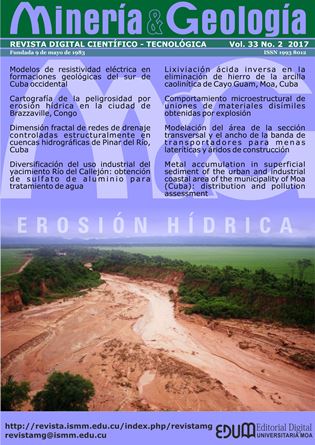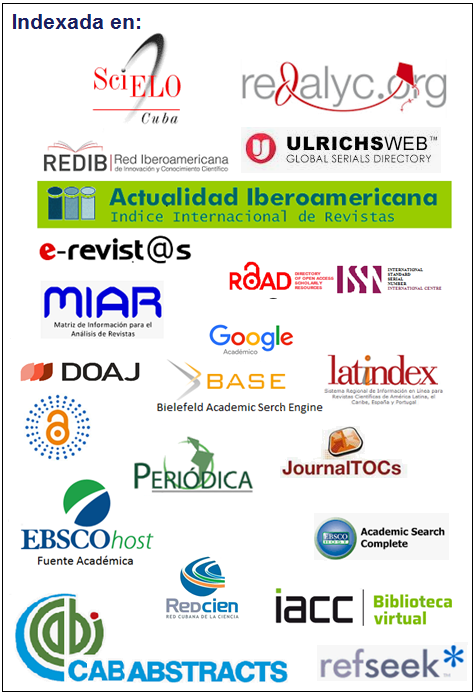Comportamiento microestructural de uniones de materiales disímiles obtenidas por explosión
Palabras clave:
soldadura por explosión, unión disímil, comportamiento microestructural, acero AISI 1020, acero AISI 1066.Resumen
Este trabajo tiene como objetivo establecer el comportamiento microestructural de uniones disímiles de titanio con acero AISI 1020 y de acero AISI 1066 con acero AISI 1008 por el proceso de soldadura por explosión. Se consideró una velocidad de detonación de 2 800 m/s, un radio de la carga de 0,345 kg y una velocidad de colisión de 1 196,16 m/s, con un volumen de explosivo de 600 cm3 y una densidad de 1,15 g/cm3. Las microestructuras obtenidas están compuestas por granos de ferrita equiaxiales, granos muy finos del tipo troostítico y grano grueso con red de ferrita. En la zona fundida de ambos materiales base se observaron granos finos y alineados del tipo ferrítico. La dureza experimentó un incremento en las muestras desde 120 HV, para el acero AISI 1008, hasta 250 HV para el AISI 1066. Se establece que la unión del acero AISI 1020 con el titanio presenta una interfase en forma de línea, a diferencia de la junta de acero AISI 1008 con el AISI 4063 que forma ondulaciones con amplitud regular, lo que garantiza un aumento en la resistencia mecánica, asociada a la ductilidad del acero AISI 1008.Descargas
Citas
ACARER, M.; GULENC, B. & FINDIK, F. 2003: Investigation of explosive welding parameters and their effects on microhardness and shear strength. Materials & Design 24(8): 659-664.
ACARER, M., GULENC, B.; FINDIK, F. 2004: The influence of some factors on steel/steel bonding quality on these characteristics of explosive welding joints. Journal of Materials Science 39(21): 6457-6466.
AL-HASSANI, S.; SALEM, S.; LAZARI, G. 1984: Explosive welding of flat plates in free flight. International Journal of Impact Engineering 1(2): 85-101.
BEN-ARTZY, A. 2010: Wave formation mechanism in magnetic pulse welding. International Journal of Impact Engineering 37(4): 397-404.
CARABALLO, M. A. & VINARDELL, C. 2004: Evaluación del comportamiento físico del acero Hadfield sometido a cargas explosivas. Minería y Geología 20(1-2): 95-101.
CELIK, A. & ALSARAN, A. 1999: Mechanical and structural properties of similar and dissimilar steel joints. Materials Characterization 43(11): 311-318.
DURGUTLU, A.; GULENC, B. & FINDIK, F. 2005: Examination of copper/stainless steel joints formed by explosive welding. Materials & Design 26(6): 497-507.
DURGUTLU, A.; OKUYUCU, H. & GULENC, B. 2008: Investigation of effect of the stand-off distance on interfaz characteristics of explosively welded copper and stainless steel. Materials & Design 29(7): 1480-1484.
FUKUI, Y. & INAMURA, T. 2004: Mechanical properties of a Ti-Nb-Al Shape Memory Alloys. Material Transaction 45(4): 1077-1085.
GARCÍA-JACOMINO, J.; BURGOS, J.; ÁLVAREZ, M. & GARCÍA, J. 2007: Efecto del tratamiento con explosivos sobre las tensiones residuales en uniones soldadas de acero al carbono. Revista de la Facultad de Ingeniería Universidad Central de Venezuela 22(2): 50-54.
GREENBERG, B.; IVANOV, M.; PATSELOV, A. & YU, P. 2012: The processes of fragmentation, intermixing and fusion upon explosion welding. Elsevier. AASRI Procedia 3(1): 66-72.
JINXIANG, Z.; KAISHIN, L.; KAI, Z.; XIAOJIE, L.; YING, L. & KAI, Z. 2005: A study on the relief of residual stresses in weldments with explosive treatment. International Journal of Solids and Structures 42(13): 3794-3806.
MADHUSUDAN, G. & SRINIVASA, R. 2009: Microstructure and mechanical properties of similar and dissimilar stainless steel electron beam and friction welds. International Journal of Advance Manufacturing Technology 45(5): 875-888.
MORIZONO, Y.; YAMAGUCHI, T. & TSUREKAWA, S. 2015: Aluminizing of High-carbon Steel by Explosive Welding and Subsequent Heat Treatment. ISIJ International 55(1): 272-277.
MOUSAVI, S. & SARTANGI, P. 2009: Experimental investigation of explosive welding of cp titanium/AISI 304 stainless steel. Materials & Design 30(3): 459-468.
PETUSHKOV, V. 2003: Peculiarities of explosion treatment of the circumferential weld on pipe filled with liquid. Paton Welding Journal 6(2): 14-16.
PETUSHKOV, V. G.; TITOV, V. A. & BRYZGALIN, A. G. 2002: Limiting thickness of welded joints to be explosion treated. Paton Welding Journal 1(3): 20-27.
WALSH, J.; SHREFFLER, R. & WILLIG, F. 1953: Limiting conditions for jet formation in high velocity collision. Journal of Apply Physics 24(3): 349-359.
Publicado
Cómo citar
Número
Sección
Los autores que publican en esta revista están de acuerdo con los siguientes términos:
- Licencia Creative Commons Atribución-NoComercial permite que el beneficiario de la licencia tenga el derecho de copiar, distribuir, exhibir y representar la obra y hacer obras derivadas para fines no comerciales siempre y cuando reconozca y cite la obra de la forma especificada por el autor o el licenciante.
- Los autores pueden establecer por separado acuerdos adicionales para la distribución no exclusiva de la versión de la obra publicada en la revista (por ejemplo, situarlo en un repositorio institucional o publicarlo en un libro), con un reconocimiento de su publicación inicial en esta revista.
- Se permite y se anima a los autores a difundir sus trabajos electrónicamente (por ejemplo, en repositorios institucionales o en su propio sitio web) antes y durante el proceso de envío, ya que puede dar lugar a intercambios productivos, así como a una citación más temprana y mayor de los trabajos publicados (Véase The Effect of Open Access) (en inglés).
- Lo anterior debe realizarse siempre sobre el artículo ya publicado por Minería y Geología.
La revista permite que los autores tengan los derechos de autor sin restricciones
La revista permite que los autores conserven los derechos de publicación sin restricciones




